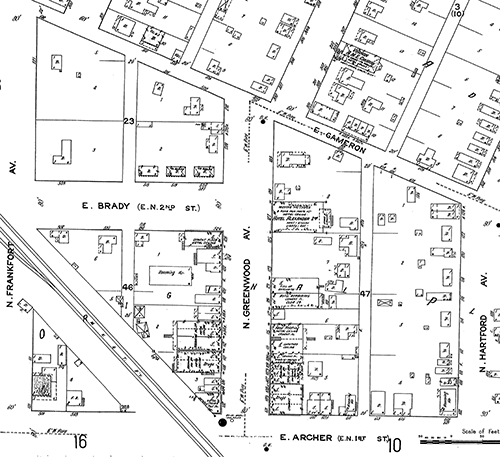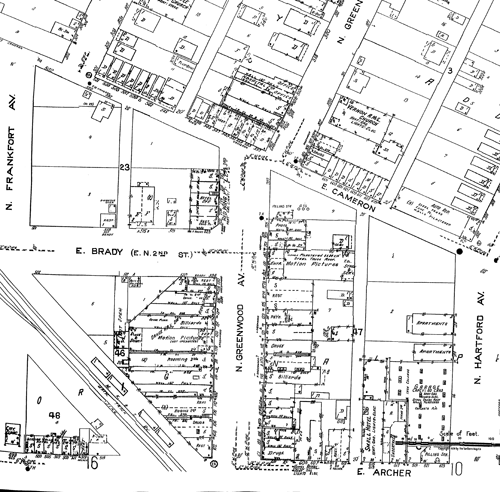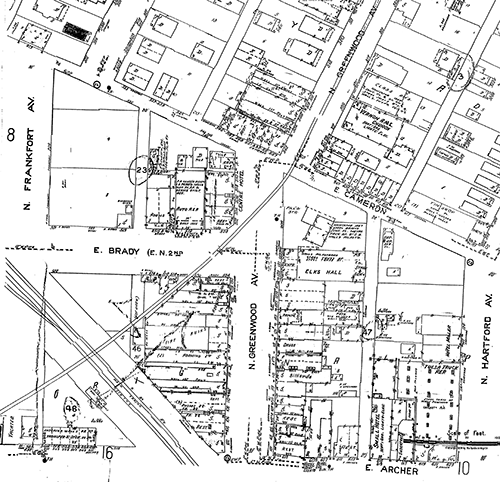Greenwood since the 1921 Tulsa Race Massacre
On the night of May 31, 1921, a white mob descended upon Tulsa's African-American district, known as Greenwood after its principal avenue, looting, shooting, and firebombing into the following day. The attack killed hundreds and left thousands wounded and homeless and destroyed dozens of African-American businesses and churches.
Once hushed up, the attack known as the Tulsa Race Riot has received an increasing amount of public attention in recent decades. I have half a shelf taken up with books on the topic, and I will leave that history to others who have told it far better than I could ever hope to do.
What is often overlooked is the triumph and tragedy that followed the riot. The story of Tulsa's Greenwood District did not end in 1921, and over the last few years I've taken it upon myself to learn that story and attempt to bring it to a broader audience.
After the riot, there was an attempt by the city's white leaders to keep Greenwood from being rebuilt. The City Commission passed an ordinance extending the fire limits to include Greenwood, prohibiting frame houses from being rebuilt. The idea was to designate the district for industrial use and resettle blacks to a new place further away from downtown, outside the city limits.African-American attorneys won an injunction against the new fire ordinance; the court decreed that it constituted a violation of the Fourth Amendment, a taking of property without due process. The injunction opened the door for Greenwood residents to rebuild.
They did it themselves, without insurance funds (most policies had a riot exclusion) or any other significant outside aid....
The Greenwood district flourished well into the 1950s. In 1938, businessmen formed the Greenwood Chamber of Commerce. A 1942 directory lists 242 businesses, including over 50 eateries, 38 grocers, a half dozen clothing stores, plus florists, physicians, attorneys, furriers, bakeries, theaters, and jewelers -- more than before the riot 21 years earlier. The 1957 city directory reveals a similar level of commercial activity in Greenwood....
The rebuilding, subsequent renaissance, and final removal of Greenwood are documented by aerial and street photos, land records, fire insurance maps, newspaper stories, street directories, and census data.
All that raw data is fleshed out in the memories of those who lived through those times. Some of those stories have been captured in books like They Came Searching by Eddie Faye Gates and Black Wall Street by Hannibal Johnson.
Here are a couple of reminiscences included by Gates in her book that clearly connect the term Black Wall Street to the post-riot, rebuilt Greenwood:
"They just were not going to be kept down. They were determined not to give up. So they rebuilt Greenwood and it was just wonderful. It became known as The Black Wall Street of America."
- Eunice Jackson"The North Tulsa after the riot was even more impressive than before the riot. That is when Greenwood became known as 'The Black Wall Street of America.'"
- Juanita Alexander Lewis Hopkins
But then came the planners:
"Slum clearance," as a cure for Greenwood's ills, had been discussed for years, but in 1967, Tulsa was accepted into the Federal Model Cities program.Model Cities was not just an ordinary urban renewal program. It was intended to be an improvement over the old method of bulldozing depressed neighborhoods. The Federal government provided four dollars for every dollar of local funding, and the plan involved advisory councils of local residents and attempted to address education, economic development, and health care as well as dilapidated buildings.
For all the frills, Model Cities was still primarily an urban removal program: Save the neighborhood by destroying it. Homes and businesses were cleared for the construction of I-244 and US 75 and for assemblage into larger tracts that might attract developers. Displaced blacks moved north, into neighborhoods that had been built in the '50s for working class whites.
Only the determination of a few community leaders saved a cluster of buildings in Deep Greenwood -- but these buildings are isolated from any residential area, cut off from community.
In April 1970, as Tulsa's Model Cities urban renewal program was beginning to demolish homes, Mabel Little, whose new home was burned down in the 1921 attack, told the Tulsa City Commission [from the April 11, 1970, Tulsa Tribune]:
"You destroyed everything we had. I was here in it, and the people are suffering more now than they did then."
Years later, Jobie Holderness reflected on the spiritual damage done by urban renewal:
"Urban renewal not only took away our property, but something else more important -- our black unity, our pride, our sense of achievement and history. We need to regain that. Our youth missed that and that is why they are lost today, that is why they are in 'limbo' now."
Here's my talk on this topic at Ignite Tulsa in 2009:
And here are links to previous BatesLine entries about Greenwood's renaissance:
The Greenwood Gap Theory: My June 2007 Urban Tulsa Weekly column on the popular misconception, abetted by the second destruction due to urban renewal, that Greenwood was not rebuilt after the 1921 massacre.
Notes on the sources documenting Greenwood's post-riot renaissance: My response to OSU-Tulsa history professor J. S. Maloy, who disbelieved my account of the post-massacre revival of Greenwood.
Greenwood 1957: A summary of commercial activity in Greenwood, based on the 1957 Polk street directory of Tulsa.
Greenwood's streetcar: The Sand Springs Railroad (includes photos)
The rise and fall of Greenwood (includes high res 1951 aerial photo of Deep Greenwood)
Tulsa 1957 restaurants: A KML (Google Maps) file locating restaurants listed in the 1957 street and phone directories, including many that lined Greenwood Ave.
Film of Oklahoma's 1920's black communities
Finally, here at a glance are three Sanborn maps from 1915, 1939, and 1962, showing Deep Greenwood over the decades:
Sanborn Map: Deep Greenwood in 1915

Sanborn Map: Deep Greenwood in 1939

Sanborn Map: Deep Greenwood in 1962

FOLLOW-UPS:
- Tate Brady, the Klan, and the attack on Greenwood
- Brenda Terry (Flash Terry's daughter) on Greenwood in the '40s and '50s
- Films of Greenwood post-riot and Oklahoma's African-American communities in the 1920s (the Solomon Sir Jones collection)
- Smithsonian Channel mangles Greenwood history
- Greenwood demolition in 1967 for expressway construction: "There is no Negro business district anymore"
- Greenwood Gap Theory: Tulsa's Green Book places weren't destroyed in 1921
- Segregation by Design: Greenwood and I-244: Adam Paul Susaneck's stark, graphical depiction showing the destruction wrought by the path of I-244 through Greenwood and neighboring districts, and the Guardian article on plans to remove I-244
UPDATE 2020/06/03: Since this article has become a central repository of links to my work on Greenwood, I'm updating the title, which was originally "The 1921 Tulsa Race Riot and the 90 years that followed." I've also changed the first paragraph to be less date-specific. It originally read: "Today is the 90th anniversary of a white mob's attack on Tulsa's African-American district, known as Greenwood after its principal avenue. The attack, which began the evening of May 31, 1921, killed hundreds and left thousands wounded and homeless." I also changed the phrase "over the last 30 years" to "in recent decades."
1 TrackBacks
Listed below are links to blogs that reference this entry: Greenwood since the 1921 Tulsa Race Massacre.
TrackBack URL for this entry: https://www.batesline.com/cgi-bin/mt/mt-tb.cgi/6000
One of the fun things about blogging for over eight years is when someone posts a comment or sends an email about a long-ago blog entry. Someone is searching on the web for information, perhaps about family or friends, and finds one of my entries, then... Read More
Thanks Mike for continuing to put this research up. I am going to check and see if the books you reference are available on Amazon.
The underlying truth that urban renewal destroyed, what one of the most devastating riots could not, is astounding.
As I'm sure you know, one other contributing factor in that time is desegregation and middle class black flight from North Tulsa. I noticed in the census data that although drastic desegregation occurred throughout Tulsa from the sixties on, the only two areas that are almost entirely black are the western part of North Tulsa and 61st and Peoria, coincidentally where the crime and poverty are highest. The same generational pull towards the suburbs seems to have had the same influence on black professionals as with white folks to the suburbs. It's just that the consequences were much more dire for North Tulsa due to racism, urban renewal and other misguided social/political policies. Thanks again for your work.
Thanks Mike for the information posted on this site regarding Greenwood's Post Riot history.
I am actually the oldest daughter of Flash Terry, you mentioned him briefly in your presentation. Recently my mother spoke about musicians who visited our house in the late 1950's before they were famous (i.e. Curtis Mayfield, Bobby Blues Bland, but that's another story).
My mother grew up on North Owasso, west of Peoria during the late 40's after her mother died. Her mother, before she died in 1940, lived directly across the street from the Mt. Rose Baptist Church on Lansing. She speaks fondly of those days, and of Greenwood. Actually everyone you speak with about Greenwood who is old enough to remember the 20's, 30's, 40's, 50's and 60's in those days, speak with a hint of pride in their eyes, and a longing for the unity and pride they experience is visable in their voices. One of the memories I have as a very small child in the late 50's, is of my aunt who lived in one of the rooming houses on Deep Greenwood (looks like one of the homes in the photos posted). She worked as a dispatcher for a taxi company. Even now I can remember how bustling and alive the area was back then. When I think of the history plowed down in the name of progress, my heart sinks. The neigborhoods were a testimony for strong and determined people, who in some cases, had fought their way up from the bonds of slavery. During Urban Renewal development, my great-grandmother's home (where I was born),and rental property were destroyed, Years later, Dunbar Elementary School where both my mother and her children attended, destroyed. I am ashamed that every residence who had history in not only Greenwood, but North Lansing, Owasso, and other streets now under I75, did not make their voices heard, and more importantly make themselves understood. I was a teenager at the time with no interest in history, but since I began researching my family history, I have learned that to know our history is to understand ourselves. Without this knowledge we have no foundation and lack direction.
Thanks again and with deep regards, Brenda.
Brenda, thank you so much for sharing your memories and for your powerful point about the importance of knowing our history. I would love to interview you, your mother, and anyone else willing to reminisce about Greenwood in the '20s through '60s and hear more about the places you remember.
Not really a riot, more of a battle... I refer to it as "The Battle of Greenwood", riot makes it sound like a small thing in the streets.